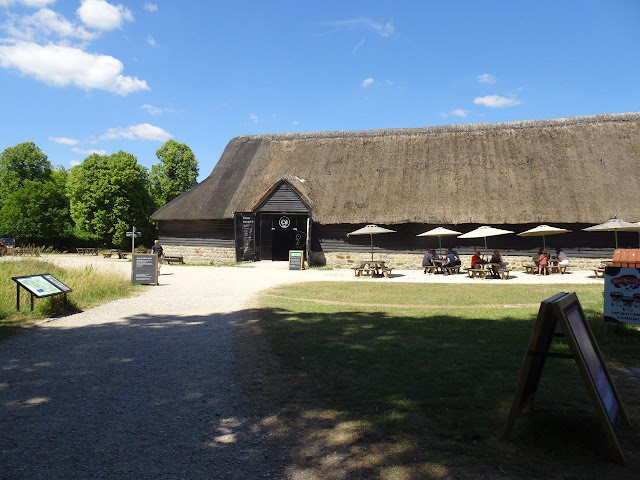While Stonehenge gets most of the tourists and publicity, in reality, Avebury and the other ancient sites on the Salisbury Plain near Stonehenge are just as important as Stonehenge, and are important to understanding this area fully. In other words, Stonehenge is not just an isolated circle of stones that a group of people put up several thousand years ago. It was part of a larger group of sites built and used by those same people and their descendants for a thousand years.
Go to Stonehenge along with the other busloads of tourists, but don't skip Avebury and the other places the ancients built and used in those times. They are critical to understanding the larger picture of those times, and people's beliefs and culture.
This Great Barn is the visitor center at Averbury and was originally built in 1690 as part of Avebury Manor Farm. Until a few years ago, it served as the museum for Avebury, but the items have been moved to a nearby building. The barn is used occasionally for temporary exhibits, but it is really interesting in itself, and is a Grade 1 listed barn by
More information on the barn and farm can be found here: https://www.nationaltrust.org.uk/visit/wiltshire/avebury/visit-the-old-farmyard-and-museum-at-avebury


You may have noticed by now that I like to take photos of roofs. Most people walk into a historic site and look only at those things around them, but you can learn a lot about something if you look up and look down. As you look at the next few photos carefully, you realize that some of these timbers are whole trees and many of them seem to have been used in previous structures.
Note the holes in the two horizontal beams shown here and indicating they had been used previously. Also note that the right vertical post also have holes in the top, and the left vertical post is not quite vertical! It is a rough tree, now squared off, and with the original bend of the living tree still there. Also note how many connections have been reinforced in modern times with steel. There are also some earlier reinforcing done by adding an extra connection.
Basically, people used what they had in those days. And it worked because this barn is 350 years old and still standing! The original barn did not have a single nail in it! Nails were available in those times, but expensive so not commonly used.
This photo shows the complicated construction at the top of this post which is clearly a barely worked tree.
The Alexander Keiller Museum is in a stone farm building near the Great Barn visitor center. It was named after the man who did much of the early discover of the Avebury site.
This shows the village of Avebury and the location of the stone circle.
A henge consists of a circle of large stones and a ditch. Unlike ditches or moats around castles that are built for defensive purposes, these ditches were ceremonial, not defensive. The circle is 1089' in diameter and originally had at least 98 stones on the outside ring. The ditch is now about 30' deep, but was originally 55' deep, so you can imagine how long this took to complete with bone and stone tools and wicker baskets to carry away the dirt.
Part of the stone circle is immediately behind the barn, shown below.
At Stonehenge, there is a fence around the circle which prevents you from getting close to them. At Avebury, you can walk up to any of them and touch them.
A good view of the ditch.


















No comments:
Post a Comment